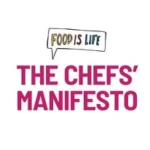On the 14th of October, dignitaries of the 46th Session of the Committee on World Food Security gathered to discuss the role of sustainable aquaculture in addressing climate change, nutrition challenges and hunger, and safeguarding livelihoods.
Hosted by the Permanent Representation of Peru to the International Organizations based in Rome, the UN Food and Agriculture Organisations, the CFS Secretariat and the SDG 2 Advocacy Hub, the Sustainable Aquaculture & Healthy Diets: Cocktail Event invited five chefs from around the world to curate dishes that tell the story of sustainable seafood on the plate.

“A way of achieving Zero Hunger and ending malnutrition is through sustainable seafood and aquaculture,” says Mario Arvelo, Chair of CFS. Blue food (seafood) is vital for environmental sustainability and healthy human diets. The EAT-Lancet identifies seafood as an important source of protein that, if sustainably managed and eaten in modest quantities, can be sourced without damage to ocean ecosystems.
“In Italy, people eat a small number of fish species when there are many to choose from,” says Chef Cristina. “Lake fish, for example, are highly nutritious and have good flavour but aren’t eaten because of the false perceptions of this food.” Through her menus and work as a food ambassador for Italy, Chef Cristina aims to alter perceptions and promote a more balanced, diverse consumption of seafood. To drive home this point of sustainable consumption, Chef Cristina plates a Smokey Mushroom Tea.

Peruvian Chef Mayra Flores, who specialises in Nikkei, a fusion cuisine that marries Japanese cooking techniques with Peruvian ingredients, works closely with local fisher people to source good quality, local and seasonal fish species rich in iron and other micronutrients. As anaemia is a prevalent issue in her country, Chef Mayra adapts traditional recipes to include iron-rich foods and adds them to her menu. In Rome, Chef Mayra tells this story through her Nikkei mackerel ususukuri with uchucuta.


South African Chef Coco Reinarhz chooses to cook Pépé- Soupe Ya Mbisi, a traditional dish from the Democratic Republic of the Congo, to highlight the country’s on-going food crisis. Adding local, sustainably sourced white fish fillets, Chef Coco adapts the traditional recipe to include DRC and Italian ingredients to tell the story of sustainability.

“Protecting biodiversity is very important when you have to feed a growing population. Yet, we’re losing these resources every day,” Indian Chef Megha reminds us. “Delhi is blessed to have different seasons, which give us so much diversity in produce, and as chefs it is our responsibility to celebrate the different ingredients.” In her restaurant Lavaash by Saby, Chef Megha champions different biodiverse ingredients on her menu each month and hosts cooking classes. To tell this story on the plate, Chef Megha plates a dish of Kodo Millet and Cod Fish Khichari with Smoked Mustard Oil Bihari Chutney and Tuscan Kale.

Ever since discovering Kvarøy algae-fed salmon in Norway, American Chef Sammy Mansour has been using it for cooking. “Not only can algae feeding improve the nutrient quality of the fish we eat, but it also improves the sustainability of aquaculture by reducing the quantity of wild fish in fish feed,” explains Chef Sammy. Together with his Chef de Cuisine Nate, Chef Sammy tells this story by serving a Citrus Salmon toast with Charred Fennel and Pomegranate Salsa, fig-kumquat shrub, hickory smoked hazelnut chestnut gremolata and fennel pollen.


Bringing the evening to an end, Ms Anna Lartey, Head of Nutrition at FAO, highlights the link between healthy waters and healthy people, and the importance of seafood in delivering important macro nutrients lacking in many diets around the world.













